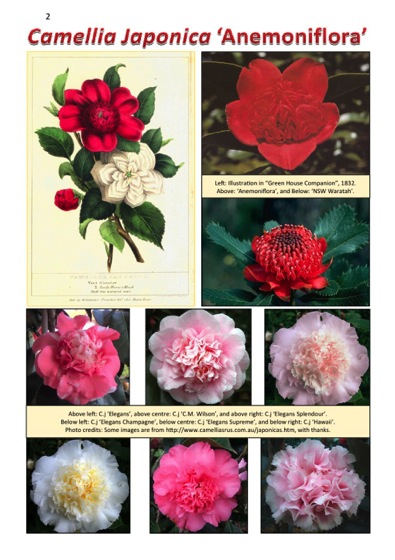Camellia japonica ‘Anemoniflora’
I first saw this plant via a BBC Gardeners World episode where they highlighted many different camellias. I only have one camellia bush here in the grade in a dark read color with a yellow center, but I see them throughout the neighborhood and in the various botanical gardens here in the Los Angeles area. Descanso Gardens, in nearby La Cañada Flintridge, has large camellia plantings, in fact. They are also named an “International Camellia Garden of Excellence” by the International Camellia Society.
Camellia japonica (the Japanese camellia) is one of the best known species of the genus Camellia. Sometimes called the Rose of winter,[1] it belongs to the Theaceae family. It is the official state flower of Alabama.
In the wild, it is found in mainland China (Shandong, east Zhejiang), Taiwan, southern Korea and southern Japan.[2] It grows in forests, at altitudes of around 300–1,100 metres (980–3,610 ft).[3]
Camellia japonica is a flowering tree or shrub, usually 1.5–6 metres (4.9–19.7 ft) tall, but occasionally up to 11 metres (36 ft) tall. Some cultivated varieties achieve a size of 72m² or more. The youngest branches are purplish-brown, becoming grayish-brown as they age. The alternate leathery leaves are dark green on the top side, paler on the underside, usually 5–11 centimetres (2.0–4.3 in) long by 2.5–6 centimetres (1.0–2.4 in) wide with a stalk (petiole) about 5–10 millimetres (0.2–0.4 in) long. The base of the leaf is pointed (cuneate), the margins are very finely toothed (serrulate) and the tip somewhat pointed.[3]
In the wild, flowering is between January and March. The flowers appear along the branches, particularly towards the ends, and have very short stems. They occur either alone or in pairs, and are 6–10 centimetres (2.4–3.9 in) across. There are about nine greenish bracteoles and sepals. Flowers of the wild species have six or seven rose or white petals, each 3–4.5 centimetres (1.2–1.8 in) long by 1.5–2.5 centimetres (0.6–1.0 in) wide; the innermost petals are joined at the base for up to a third of their length. (Cultivated forms often have more petals.) The numerous stamens are 2.5–3.5 centimetres (1.0–1.4 in) long, the outer whorl being joined at the base for up to 2.5 centimetres (1.0 in). The three-lobed style is about 3 centimetres (1.2 in) long.[3]
The fruit consists of a globe-shaped capsule with three compartments (locules), each with one or two large brown seeds with a diameter of 1–2 centimetres (0.4–0.8 in). Fruiting occurs in September to October in the wild.[3]
C. japonica leaves are eaten by the caterpillars of some Lepidoptera, such as The Engrailed (Ectropis crepuscularia). The Japanese white eye bird (Zosterops japonica) pollinates Camellia japonica.[4] — Wikipedia.org
Previously in the Interesting Plant series:
- Zaluzianskya villosa “Southern Lilac Drumsticks”
- Prickly Pear Cactus (Opuntia)
- Campanula
- Rudbeckia
- Caladium bicolor ‘White Queen’
- Fuchsia
- Palo Verde Tree (Parkinsonia florida)
- Espalier Fruit Trees
- California Poppy (Eschscholzia californica)
- Hydrangea ‘Zorro’
- Harlequin flower (Sparaxis tricolor)
- Erythronium
- Sempervivum
- Primula auricula
- Feathery Cassia (Senna auricula)
- Red Stick Dogwood (Cornus alba ‘Sibirica’)
- Japanese Maple (Acer palmatum)
- Kousa Dogwood (Cornus kousa)
- Giant Chalk Dudleya (Dudleya brittonii)
- Sunrose (Helianthemum nummularium)
- Australian/New Zealand Tea Tree (Leptospermum scoparium)
- Brugmansia Sanguinea
- Calico Monkeyflower (Mimulus pictus)
- Colocasia Esculenta
- Acer palmatum ‘Sango-kaku’ (Coral Bark Japanese Maple)
- Linderniaceae (formerly Torenia) Kuaui Deep Blue
- Passiflora (Passion flower)
- Firewheel Tree (Stenocarpus sinuatus)
- Anemone
- Allium Cowanii
- Symphyotrichum oblongifolius (Purple Aster)
- Hemerocallis ‘Derrick Cane’ (Daylily)
- Agastache ‘Aztec Rose’
- Rudbeckia hirta Moreno
- Kalanchoe Tomentosa
- Albuca namaquensis
- Hosta ‘Remember Me’
- Dahlia ‘Clair de Lune’
- Lovely silver-tinged fern on campus of Oberlin College, Ohio
- Tricolor Beech (Fagus sylvatica Purpurea Tricolor)
- Climbing Hydrangea (Hydrangea anomala petiolaris)
- Eremurus ‘Lemon Meringue’
- Lupine “Sunrise” (Lupinus hartwegii)
- Chinese Fringe Flower (Loropetalum chinense)
- Streptocarpus ‘Harlequin Blue’
- Nigella damascena (love-in-a-mist, ragged lady)
- Epiphyllum (Orchid Cactus)
- Sempervivum ‘Westerlin’
- Gladiolus ‘Kings Lynn’
- Hosta sieboldiana ‘Dorothy Benedict’
- Begonia “Escargot”
- Asparagus Pea (Psophocarpus tetragonolobus)
- Rosa banksiae (Lady Banks’ Rose)
- Primula ‘Victoriana Silver Laced Black’
- Oxalis versicolor
- Poached Egg Plant (Limnanthes douglasii)
- Parisian Carrots
- Fritillaria imperialis Rubra Maxima
- Clematis “Fascination”
- Swiss Chard “Bright Lights”
- Georgia Rattlesnake Melon
- Dianthus Barbathus “Green Ball” or “Green Trick”
- Coleus “Religious Radish”
- Black Forest Calla Lily
- Black Bamboo
Interesting Plant is a series from A Gardener’s Notebook blog and podcast that highlights the most interesting plants I find in my Internet and real-world travels — Douglas







